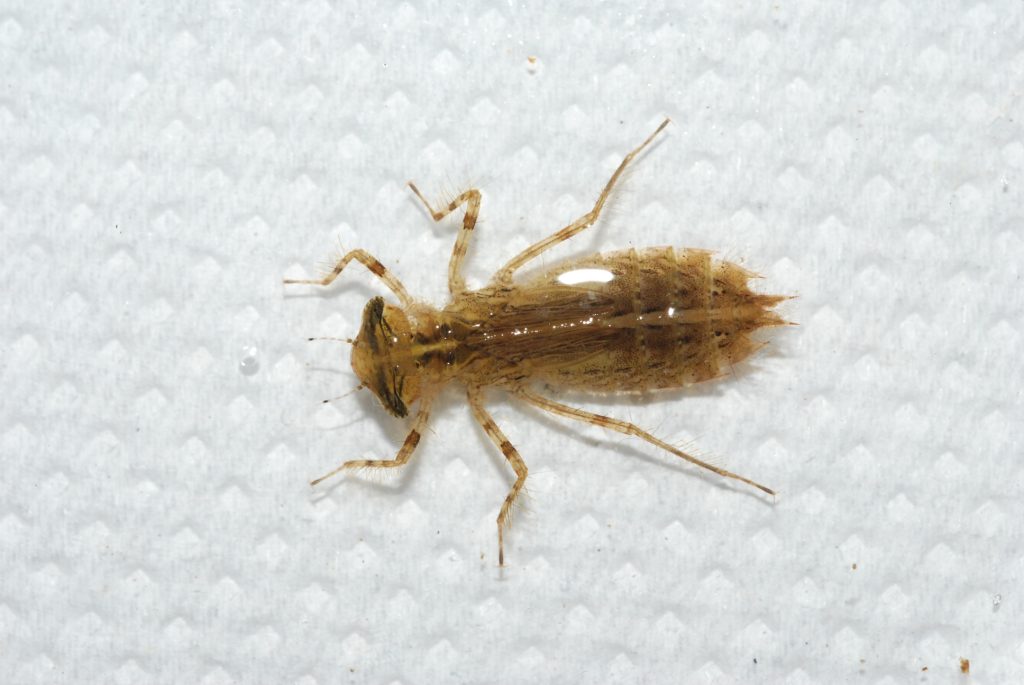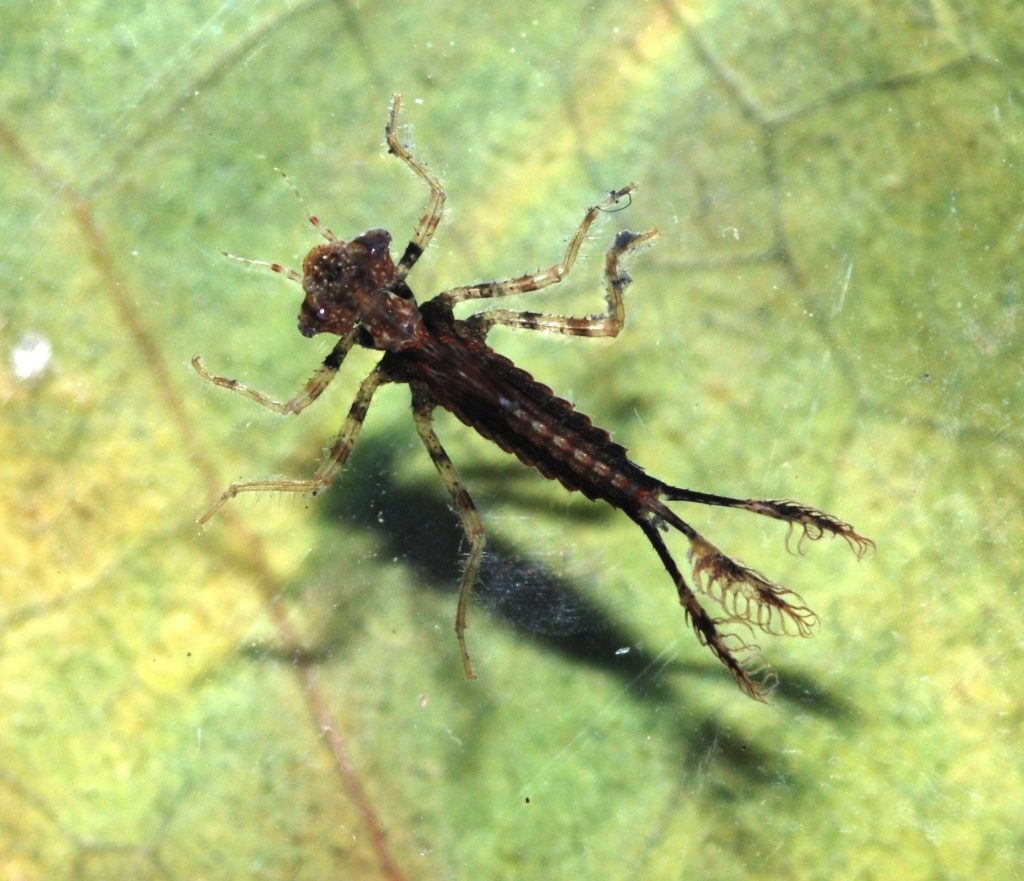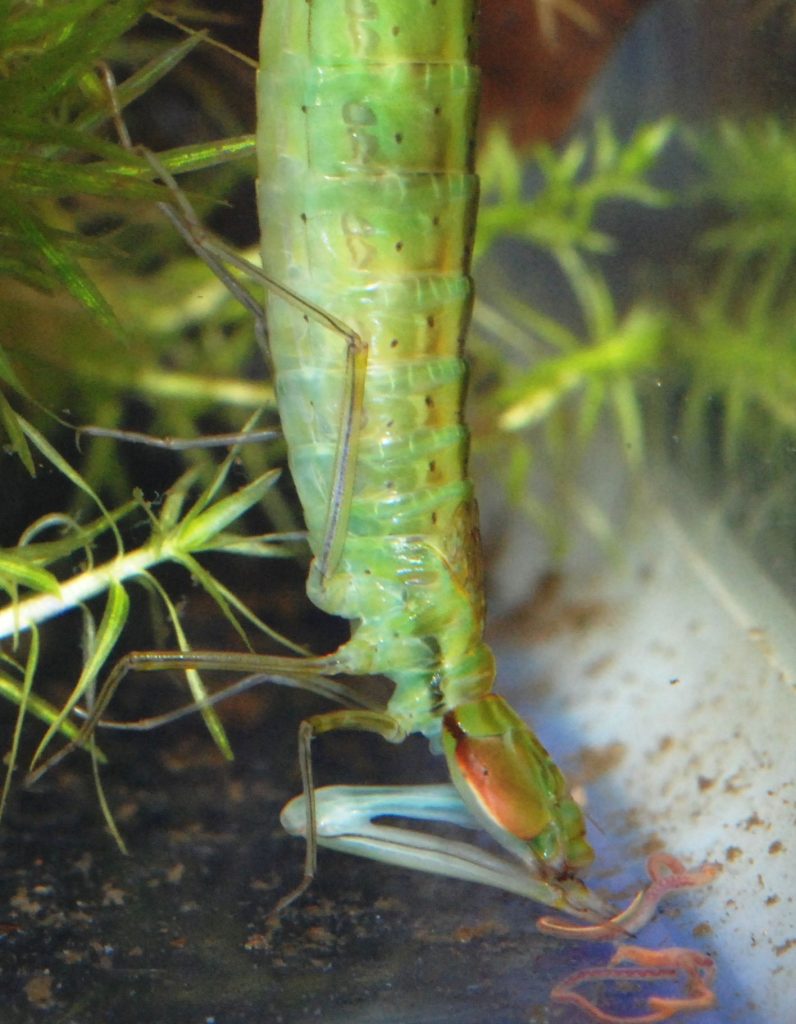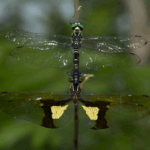Dragonflies – while the origin of their name is a mystery, it is an appropriate description of these voracious predators. Both the aquatic nymphs and the flying adults are some of the largest and most aggressive insect hunters in the world.
Dragonfly nymphs live in the water and usually hang out on aquatic vegetation waiting for their prey, which is virtually any animal small enough to grab. When prey gets close enough, the nymph unfurls its labium (mouthpart that shoots out past the head) to capture its prey. Larger dragonfly nymphs may even eat minnows or tadpoles.
The fearsome feeding behavior of dragonflies demonstrates their skill and efficiency as predators. Beautiful as they are, dragonflies mean business when it comes to hunting for food. They capture an amazing 95% of their intended prey! For comparison, sharks and lions capture 50% and 25% of their prey, respectively, far short of the dragonfly’s hunting ability.
Adult dragonflies will also eat any insect they can catch. While they usually eat mosquitoes and midges, they’ll also eat butterflies, moths, bees, flies and even other dragonflies. Larger dragonflies will eat their own body weight in insect prey every day.

WHAT DO DRAGONFLIES EAT? AND OTHER DRAGONFLY FACTS
What do dragonflies eat?
Dragonflies eat other insects, such as flies, midges and mosquitoes. They will also take butterflies and even smaller dragonflies. Prey is normally caught in mid-air, with the dragonfly using its long legs to catch its quarry. the food will them be carried to a perch where it is eaten.
What is the difference between dragonflies and damselflies?
Dragonflies and damselflies appear similar, but there are some key differences. Dragonflies tend to be larger with bulkier bodies, while damselflies are more slender. When resting, a dragonfly keeps its wings open, but damselflies fold theirs on top of their bodies. Dragonfly eyes touch in the middle, while damselfly eyes sit separately on either side of their heads. Finally, dragonflies have a strong direct flight, while damselflies fly in a fluttery fashion.
Dragonflies are literally built for catching and killing their next meal.
FLIGHT & FEEDING
Dragonflies have perfected the art of eating on the run, or more precisely eating while in flight! They are able to track their moving prey (e.g., mosquitoes, flies) and intercept it while flying. Their high capture rate is related to their ability to determine where their prey will be when they catch up to it. In the span of milliseconds, dragonflies need to calculate the distance of their prey, the direction that their prey is moving, and the speed that their prey is flying. With that information, the dragonfly determines the best approach angle to catch their meal. Because of the way that their wings work, dragonflies can fly in any direction and can change direction instantly.
VISION & FEEDING
A dragonfly’s ability to fly is matched by its ability to see. Like most insects, dragonflies have multifaceted eyes. With 30,000 individual facets, dragonflies have significantly more facets than any other insect (e.g., house flies have 6,000). Each facet creates its own image and the 30,000 images are compiled into one image. This allows dragonflies to have a 360-degree view of their environment without any blind spots.
To make their vision powers even more remarkable, dragonflies can see the normal color spectrum (red, green, blue), as well as UV light and the polarized light waves. The ability to see polarized light waves helps them to reduce the impact of sun glare on their vision; this is similar to the effect we have when wearing polarized sunglasses.
Put another check in the incredible column! Dragonflies can track and isolate their prey in a swarm. They have the ability to shift from one object to another, keeping track of where each potential prey is positioned in a swarm. When a dragonfly singles out one target, it is able to capture it without colliding with another member of the swarm.

WHAT DO DRAGONFLIES EAT?
Dragonflies are voracious eaters and their preferred prey are mosquitoes and small flies. Each dragonfly can consume up to 100s of mosquitoes per day! They will also eat bees, butterflies, and even other dragonflies.
THE MECHANICS OF EATING (AKA TABLE MANNERS OR THE LACK THEREOF)
What happens at the moment a dragonfly intercepts its prey? It is not pretty! Smaller insects like mosquitoes are caught directly by the mouth. Larger insects, like flies, are first trapped by a dragonfly’s front legs. Once trapped, the dragonfly will use its powerful serrated jaws (mandibles) to clamp down and shred the wings of the prey, thereby immobilizing it. The dragonfly, with its hinged jaws that can open as wide as its head, is then able to consume the rest of its meal.
WHAT IS IN A NAME?
Dragonflies are fitting members of the Odonata order. The name Odonata, derives from the Greek “odonto”, meaning tooth, and refers to the strong teeth found on the jaws of most adults. We are sure that after learning about the feeding behavior of dragonflies, you will agree that their scientific classification is particularly appropriate!
WHAT DO ADULT DRAGONFLIES EAT AND DO THEY BITE?
If you look at the face of a dragonfly they look like a cross between an insect, Gomez Adams from Adams Family, and flying a ninja.
You can see the big compound eyes easily, and they have two tiny antennae that look like Gomez’s mustache, and then their mouth bits. These mouth parts are the business end of things that help address the question, “What do dragonflies eat?”
I’m not going to go into the technical biological labels of upper and lower lips and seams, sutures, frons, or plates. The main thing to notice is that they have jaws that work side to side and that are shaped like wicked meat hooks, mandibles (man-dibbles) that go up and down and maxillae (max-ill-eh) that act like a lower lip and hold food. Their curved jaws are for piercing and holding insects while flying and also for defense. Remember, dragonflies are in the order Oodonata, which means “toothed-one.” This is the Greek reference to their “toothed” or serrated jaws. They most certainly can bite, as attested to a friend that once got a big dragonfly too close to her nose. However, they don’t want to bite humans and only do so as a last defense if captured.
All adult dragonflies are insectivores, which means they eat insects they catch with their spiney hairy legs. The insects are then held in a basket-like device while flying. They particularly delight in mosquitoes (30-100+ per day per dragonfly!) as well as other pesky flight bugs such as flies, butterflies, bees, and even other dragonflies. Dragonflies eat while flying and hunting at high rates of speed too, which is an incredible feat.
BUT WAIT THERE’S MORE! BUTT BLASTERS AND PREHENSILE JAWS OH MY!

Now here’s my favorite part of answering the question, “What do dragonflies eat?” We’ve talked about Memaw’s favorite sweater and adult dragonflies, but that’s only half the story. You see, those adult dragonflies start out life, as all dragonflies do, living in water as aquatic wee beasties. Female dragonflies lay their eggs in water and then the eggs hatch into the unholy terrors of the freshwater world. At this stage they are called nymphs. Now don’t get any ideas that these are beautiful nymphs frolicking through the water like Greek goddesses…nope, more like Gorgons! Take a look below.
Dragonfly nymphs are voracious hunters, eating everything in sight that moves, even things bigger than they are!! This includes tadpoles, fish, aquatic insects, worms, and more. They’re crucial predators in the underwater world, and yes, they can bite at this stage too, though to me it doesn’t hurt as much as the adults and it takes a lot to provoke one to bite.
Dragonfly nymphs have prehensile (pre-hen-sigh-el) mouth part. Prehensile just means capable of grasping or seizing. This prehensile bit, called the labium (lay-be-um) is attached just below its mandibles and eyes, and is hinged so that it can fold flat against the body. The end of the labium has two serrated teeth, much like an adults’ fierce meat hooks, and these fold up to form a face mask when not in use. The effect is that of a ninja’s face mask covering the lower portion of its face. The nymphs sit and wait for prey. When they see something munchy, their jaws shoot out within three one-hundredths of a second! The hooks snag the prey like something out of the movie Alien and drag it back to the mandibles and chewing mouth bits. Watch this video:







